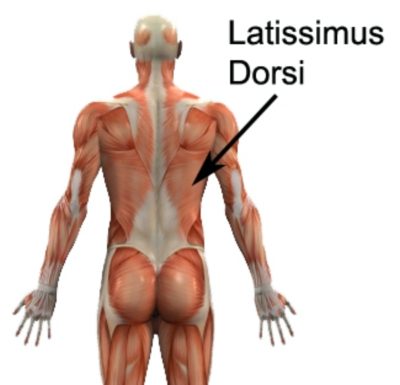Exploring Latissimus Dorsi Anatomy: Origin, Insertion, Action, and More
Updated:
Introduction
The latissimus dorsi, often simply referred to as the “lats,” is a prominent muscle of the human back. Understanding the latissimus dorsi anatomy is essential for athletes, fitness enthusiasts, and medical professionals alike. In this article, we will delve into the details of the latissimus dorsi, including its origin, insertion, action, function, nerve supply, blood supply, palpation, clinical relevance, common injuries, and provide a list of useful links to relevant PhysioAdvisor articles.

Latissimus Dorsi Anatomy
- Origin: The latissimus dorsi originates from multiple points along the lower spine (T7-L5), the sacrum, iliac crest, and the lower four ribs.
- Insertion: It inserts into the intertubercular groove of the humerus (upper arm bone), specifically the bicipital groove.
- Action: The primary action of the latissimus dorsi is the extension, adduction, and medial rotation of the shoulder joint. Additionally, it assists in forced respiration by depressing the ribcage when the arms are fixed, as well as stabilizing the torso during various movements.
- Function: This muscle plays a crucial role in several upper body movements, including pulling, lifting, and throwing. It is heavily involved in exercises such as pull-ups, chin-ups, rowing, and swimming strokes.
- Nerve Supply: The latissimus dorsi is primarily innervated by the thoracodorsal nerve, a branch of the brachial plexus (specifically, the posterior cord).
- Blood Supply: The arterial blood supply to the latissimus dorsi comes from branches of the subscapular artery, thoracodorsal artery, and the dorsal scapular artery.
Palpation of Latissimus Dorsi Anatomy
Palpating the latissimus dorsi can be done to locate trigger points, assess muscle tension, or identify areas of discomfort. To palpate the muscle:
- Begin by locating the lower edge of the scapula (shoulder blade).
- Move your fingers down and laterally, following the curve of the ribcage.
- As you move further down, you’ll feel a large, flat muscle mass – this is the latissimus dorsi.
- Gently press your fingers into the muscle and move them around to assess its texture and any areas of tenderness or tension.
Clinical Relevance of Latissimus Dorsi Anatomy
Understanding the latissimus dorsi anatomy is crucial for diagnosing and managing various musculoskeletal conditions. Some clinical applications include:
- Shoulder Dysfunction: Injuries or imbalances in the latissimus dorsi can contribute to shoulder pain and impede proper shoulder joint function.
- Postural Problems: Weak or tight latissimus dorsi muscles can lead to poor posture, especially when it comes to slouched shoulders.
- Rehabilitation: Physiotherapists often incorporate exercises targeting the latissimus dorsi in rehabilitation programs for individuals recovering from shoulder injuries or surgeries.
Common Injuries Affecting the Latissimus Dorsi
- Strains: Overuse or improper technique during exercises like pull-ups can lead to latissimus dorsi strains.
- Tendonitis: Inflammation of the tendon where the latissimus dorsi attaches to the humerus can cause pain and discomfort.
- Muscle Imbalances: Imbalances between the latissimus dorsi and opposing muscle groups can lead to postural issues and discomfort.
Useful Links (PhysioAdvisor.com.au)
References – Latissimus Dorsi Anatomy
- Latissimus Dorsi Muscle – by Ken Hub
- Moore, K. L., Dalley, A. F., & Agur, A. M. R. (2014). Clinically Oriented Anatomy (7th ed.). Lippincott Williams & Wilkins.
- Standring, S. (2016). Gray’s Anatomy: The Anatomical Basis of Clinical Practice (41st ed.). Elsevier.
- Drake, R. L., Vogl, W., & Mitchell, A. W. M. (2015). Gray’s Anatomy for Students (3rd ed.). Elsevier.
Conclusion
The latissimus dorsi is a complex muscle with a significant role in upper body movements and posture. Understanding its anatomy, function, and potential injuries is crucial for athletes, fitness enthusiasts, and healthcare professionals. Proper care and rehabilitation of the latissimus dorsi can lead to improved shoulder health and overall well-being. For more information and exercises related to the latissimus dorsi, refer to the provided links on physioadvisor.com.au.

Link to this Page
If you would like to link to this article on your website, simply copy the code below and add it to your page:
<a href="https://physioadvisor.com.au/latissimus-dorsi-anatomy”>Exploring Latissimus Dorsi Anatomy: Origin, Insertion, Action, and More – PhysioAdvisor.com</a><br/>Learn about latissimus dorsi anatomy including origin, insertion, action, innervation, blood supply, common injuries and more...
Return to the top of Exploring Latissimus Dorsi Anatomy: Origin, Insertion, Action, and More.
